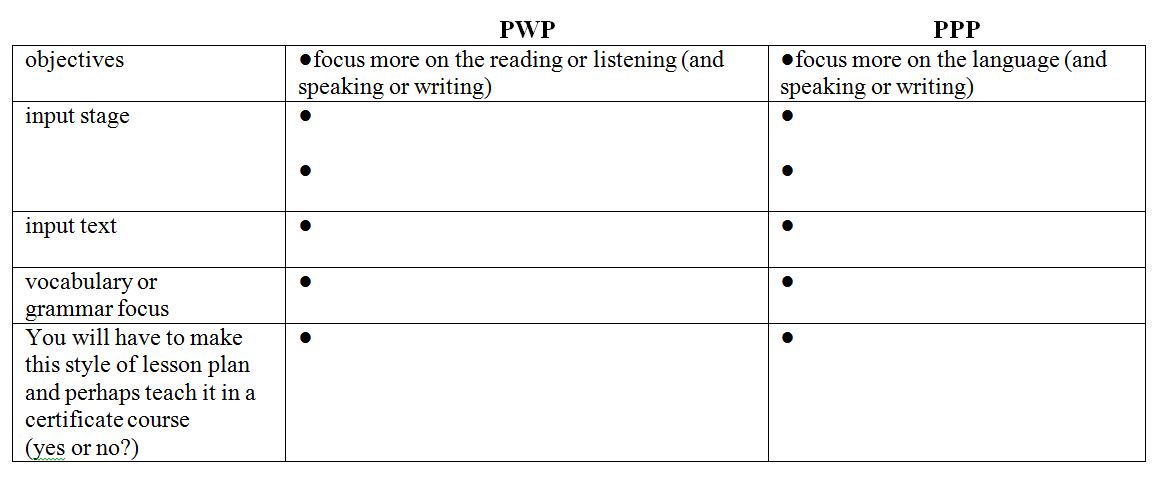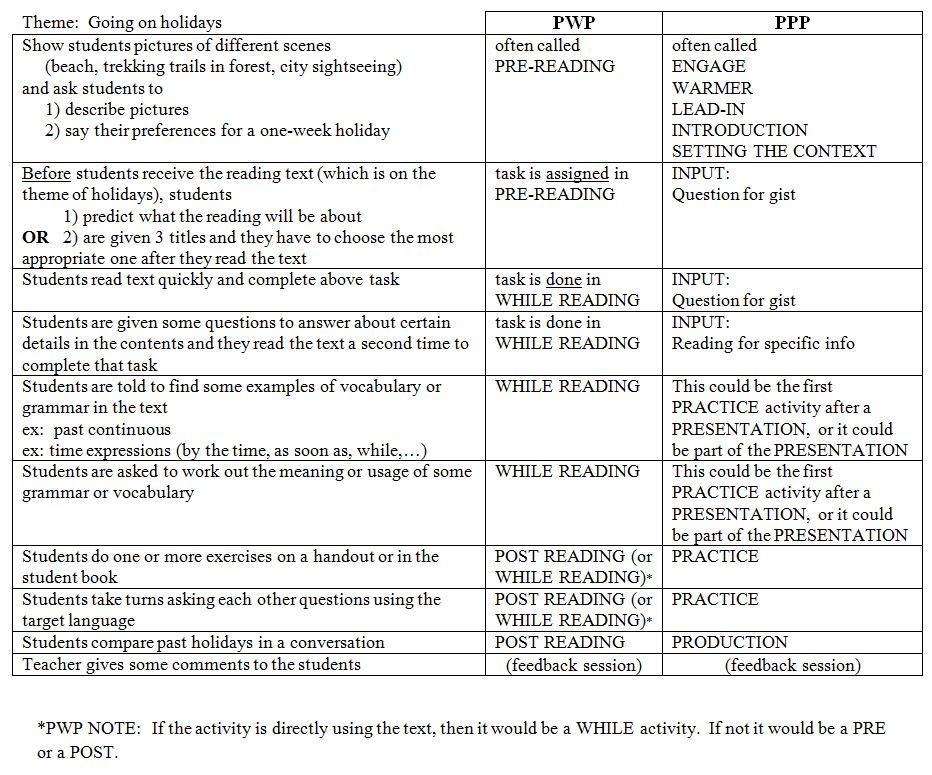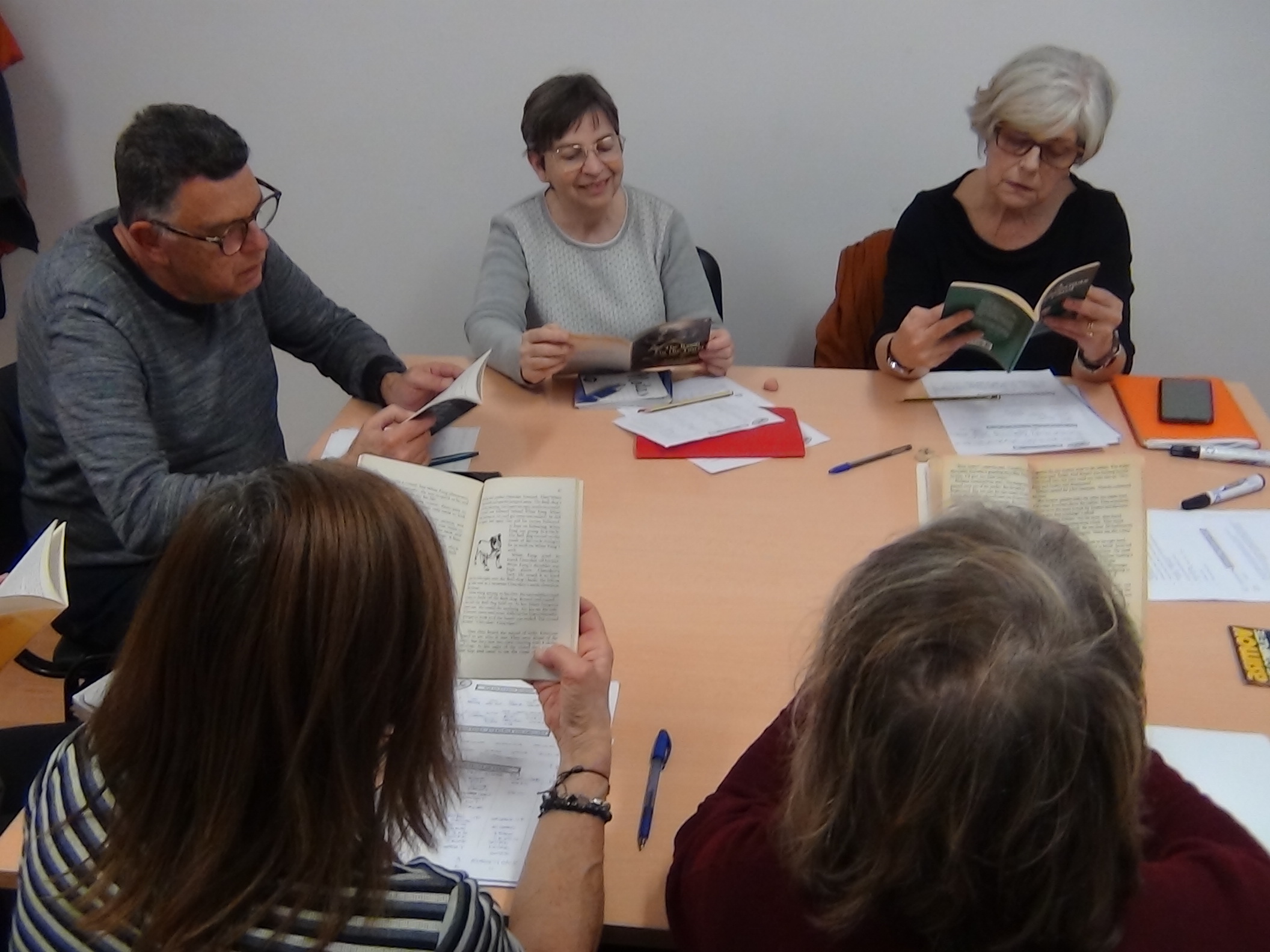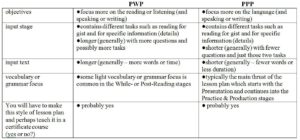A way to approach a reading or listening lesson plan
The main focus of the information presented in the PPP article has been on a particular grammar or vocabulary point. There can be other areas of focus and tt is very relevant (and frequent) for teachers to ask about what to do if they are to teach a lesson which is basically focused on a reading or listening If that is the case then the PWP could be better suited for those purposes. Again, the PWP model is a way to approach lesson planning for a class where the main focus is on a reading or listening, not on grammar or vocabulary (although grammar or vocabulary could and often does play a small role in that lesson plan).
This presentation is based on the assumption that the reader is acquainted with the PPP model. If the reader would like to refresh some of the basics it is recommended to read the PPP Explained.
Let’s have a quick look at the terminology. ‘PWP’ refers to 3 basic stages.
Pre-Reading While Reading Post Reading
This could also apply to listening or watching a video.
Pre-Listening While Listening Post Listening
Pre-Watching (or Pre-Viewing) While Watching (or While Viewing) Post Watching (or Post Viewing)
Some schools call them by slightly different names, but they’re the same thing.
Before Reading During Reading After Reading
The While stage is basically anything you do when looking at the input (of a reading text, a listening or a video). It could be answering questions about the text, looking at examples of how the language is being used, or any activity which uses that input in some way. The Pre stage is what you do before introducing the input. This usually includes some speaking activity that orientates the students to the theme of the class (which will be reflected in the input as well). The Post stage is what happens when you’re done with the input and move on to explore other things such as some grammar or vocabulary (only a little more) or more speaking about the theme. Sometimes a lesson plan doesn’t always fit so perfectly into three distinct stages because you may do a Post-Reading activity and then later return to the text.
As stated above, the PWP model is intended to be applied to a reading or listening (audio or video) lesson. For the sake of clarity, we’ll use the example of how to approach developing a reading lesson plan but a focus on listening or watching a video are very similar, with little or no changes in the Gist or Specific Information tasks, for example. Still, you might find it beneficial to your listening class to perhaps include an activity or two where the students refer to the audioscript, which could be in the form of a gap-fill, to provide a means where students can re-read some of the language being used or to look more closely at the contents for some reason.
If you have gone through the information explaining the PPP model, you will recall that with that approach the main focus is on some language point, usually a grammatical structure or some vocabulary. The PWP model is quite similar, but there is a greater thrust on the reading (or listening) and less so on the language focus. Some people find it easier to use the PWP model when they want to do a lesson on reading or listening. To get a better idea of how it works, let’s see how the two models are similar.
A HOW ARE PWP & PPP SIMILAR?
Decide if the following statements are true or false:
NOTE: If you are with another person who is also checking out this information, you can do the following exercise individually and then compare your answers. After discussing them for a brief time, confirm your answers below the exercise by clicking on the toggle bar. If you are on your own, think of what you remember or understand about the PPP model, and imagine how a reading lesson plan might compare on each of those points. Do you think it might be true that the PPP and the PWP would have the same characteristics for that particular point (like having a Gist task), or would they be very different?

Click on this to check your answers
All the answers are true. That means both the PPP and the PWP share these characteristics. That also means that if you are familiar with the PPP model, it is not a big jump to learn a bit more about this new PWP model.
B HOW ARE PWP & PPP DIFFERENT?
Think first, then look at the points below:
Alright. Now let’s look at how they are different. This can help define more clearly what the PWP consists of. Before clicking on the toggle to find a few points on how the two differ, think about it for a moment. If you are with another teacher, then speculate a little together on what those differences might be.
Some differences between the PWP and PPP models
| 1 | There is a different focus in the objectives (and this can influence how the activities are designed or carried out)
In the PWP model, the major focus could be |
|
| ● | on developing the reading subskills (Examples: skimming/reading for gist, scanning for specific information, summarizing, inferring meaning from context, reading for deeper comprehension) | |
| ● | on having the text serve as a context for other skill development such as writing (use the reading text as a reference or model) or speaking (use the reading text to stimulate further exploration into the theme) | |
| The PPP model would focus more on the language itself (usually grammar or vocabulary but could be on pronunciation, and in that case the input would more likely be a listening or video). The PWP model can still look at vocabulary or grammar, but more lightly so. | ||
| 2 | The input stage in general is usually shorter in the PPP to allow more time to explore the language focus | |
| 3 | The PWP tends to have a longer text (more words in the written text or longer in time if it’s a listening or a video). | |
| 4 | The reading for specific information task will likely have fewer questions in the PPP. | |
C A BRIEF SUMMARY OF SOME KEY POINTS
It’s one thing to read something, and it’s another thing to assimilate the information and be able to apply it. Simply reading a brief passage doesn’t usually lead to a deep understanding so I am going to encourage you to try to integrate what you have been exploring. See what you can say (think) to fill in the gaps in the chart below.

NOTE: If you are taking a TEFL / TESOL certificate course, check with your tutors about how they feel about the use of authentic, graded and modified texts. There is a range of opinions about these topics, and many interesting points to think about.
Authentic reading is a real text you would find in its natural context (such as a magazine article published for a certain market of people or a recipe or part of bestselling novel). It is not created for a language class. Some schools insist on authentic texts only, or exclusively for some kinds of assignments or situations, but they may be more relaxed for other situations. (You can shorten them if they’re too long, as long as the parts you take out don’t affect the general reading, making it less comprehensible, for example.)
Graded texts are texts often found in student books or in special graded readers. which are books written with a particular level in mind. This means the vocabulary would be more suitable for that respective level, as well as the use of different grammatical structures. Many classic novels are rewritten in this style to encourage a greater range of language learners to read in English (or the language they are studying).
Modified texts would refer to an original text which was used in one context and you modify it to make it more appropriate for your class. This could be done by eliminating difficult sections of grammar or rewriting passages that might be difficult to understand. Maybe you want to include certain structures or vocabulary that might better serve some of your objectives. There might even be cultural or other reasons. Perhaps there is a part of the text which might be offensive to some or all of the students and you wish to edit that part out.
Again, if you are taking some kind of course, check with your tutors because they may have certain expectations about your use of those different kinds of texts. For example, when you are teaching a class, all three texts might be acceptable, but perhaps for a particular assignment or project for your course, you must use only an authentic text.
Remember that we are focusing on a reading lesson plan in our PWP model, but the basic ideas also apply to a listening or video lesson plan.
D AN EXAMPLE LESSON PLAN
Have a look at how the two models compare:
There is no task for you to complete here, other than taking a moment to think about the similarities and differences between the two models.

In labelling your activities, you could assign titles or numbers such as PRACTICE 1, PRACTICE 2, etc or POST-READING 1, POST-READING 2, etc. If someone else is to read your lesson plan, then make references to each activity very clear. This also includes references to any handouts or other sources/materials. For example, Handout 1 is used in PRACTICE 1 and PRACTICE 2.
It is important here to note that some language focus is common in the PWP but it is not the major focus as in the PPP model. In the above PWP lesson plan, the teacher wants to bring a few items of grammar and vocabulary to the students’ attention and the students could be encouraged to use them while exploring the text and in other speaking activities. The Practice stage in the PPP model would be dedicated to the students developing their mastery of some grammar / vocabulary focus that requires some time. The While stage in the PWP model is more dedicated to exploring the text itself and could focus on exploring other subskills such as inferrance, reading for deeper understanding or summarizing. The Post reading stage is when you’re finished with the text and no longer need to refer to it. You’ve already extracted the ideas and any grammar / vocabulary examples in the text you wish to deal with. You still may wish to continue exploring the ideas or language but if the text is not needed to do this, then those new activities would be in the Post reading stage.
E COMPLETING A READING LESSON PLAN
ASSIGNMENT FOR A TEFL COURSE
Some tips to think about to not only help you get better marks;
but to also appreciate the expectations a little better:
You may or may not get an assignment in your course where you have to come up with a reading lesson plan following the PWP model. Each school determines their own contents and criteria. It is impossible to cover everything completely in an intensive four-week course, so each school decides what elements to emphasize and how to go about it. If you do get a reading lesson plan assignment, pay close attention to the instructions and try to understand the expectations as much as possible. The person evaluating your work will be following a rubric or guidelines on what to look for and how to award points. This will be the same for all people assigned that task, but could vary immensely from school to school. Perhaps in your assignment instructions you will be given some information to orientate you (like a class profile including the level and age of your students), but if not, you might be expected to create such a profile yourself.
It is not unusual for tutors in a course to be very helpful in some ways, but when it comes to the trainees completing the assignments, they are deliberately vague. This is because they want YOU to think it through. It will be a richer experience for you to make the effort to try to apply some of the things they have been showing you. And yes, that is very hard and frustrating. If they give you too much guidance on the tasks, then they are basically doing it for you and they can’t see where you are strong and where you need some help. (Think of the tutors answering the questions for you in the final exam. It defeats the purpose, doesn’t it?) That help can be given to you after you hand in your assignment and are graded in the form of marks and feedback. You may disagree with their marks, but listen to what they have to say and see if you can learn from it. Yes, you want to pass the course, but it’s more important to learn what is being offered. Hopefully, you will do well on both counts. If you get a low mark on some assignment, use that as motivation to focus on where to improve. Many courses have a series of assignments to complete, so if you are like many if not most trainees, there is a good chance you will get a low mark on more than one occasion, but you will have several opportunities to do well. And if you are struggling with some aspects, then the tutors might be able to identify what is difficult and offer suggestions. Nobody becomes a master by the end of the course, but it is extremely helpful to know your strengths and weaknesses and how to go about continuing to improve after the course.
When I am asked to evaluate assignments, I often notice that many trainees do (or don’t do) the same things which prevent them from getting the high marks they would like. I can’t speak for the expectations and criteria for the school you may be enrolled in, but perhaps some of these might give you some perspective and direction.
1- The tutors can’t help you do the assignment, but you can ask them if you have doubts about the instructions or expectations. Think through your question first so what you are asking is as clear as possible.
2- Read the instructions carefully and underline, circle or highlight with a coloured marker key words. If you are to use an authentic text, then don’t use a graded one. If the text is to be a certain length, then respect those parameters. The instructions are telling you what you need to do. If you do it differently or don’t do some things, you will lose some points and unfortunately, many trainees do lose points because they don’t follow the instructions.
3- Include ALL of your materials, unless specifically told not to. That means a copy of the pictures you want your students to describe in the warmer at the beginning of the class. That includes the text itself, the questions, the answer key, everything. That can also include where you got the text from, so include the link or some kind of citation reference.
4- If you are supposed to provide a lesson plan to show how you plan on teaching the class, it is a good idea to provide some details on how you intend on doing that. Those details should include:
a- time estimates for each activity (and do they add up to the length of time you were given? – such as one hour?)
b- types of interaction (pair-work, students in small groups, a class discussion, teacher to students)
c- If you are asked to present a plan for a certain time during a course (but it is not stated in the instructions exactly when in the course that class will take place) which you are to imagine you are teaching, state clearly when it is that you will be presenting that lesson plan. And design your lesson plan with that in mind. For example, a lesson plan in the third week of an absolute beginner’s course would be very different than one halfway or near the end of the course. Say when your lesson is to take place.
d- what you want to do and what you want the students to do. You don’t have to spell out every detail, but you do have to provide some details so the reader can better understand your intentions. That clarity often distinguishes trainees and is reflected in higher marks. For example, compare Trainee A’s description to Trainee B’s:
Trainee A: Give handout to students and complete sections 1 to 3.
Trainee B: Place students into pairs and tell them to first complete Section 1 individually. They can’t help each other. After a two-minute time limit, they compare answers. The teacher monitors to see which the difficult questions were and who was able to answer them correctly. When going over the answers, the teacher calls upon those students who got the answers correct to not only say them, but to say how they got to that answer. (Teacher helps out if necessary and confirms correct answers.) Sections 2 & 3 will be done in the same manner.
If you were marking the papers for Trainee A and for Trainee B, who would you award higher marks to? Perhaps Trainee A had some very good ideas or understood the same procedure as Trainee B, but if those ideas and details weren’t communicated, then it is difficult for the tutor to give those marks. And if Trainee B was making some fundamental errors, then it would be easier for the tutor to see the problem and give more customized advice and guidance.
5- Clearly label everything. Make sure the name you give to one of the items in your materials is the same one when you refer to it in your lesson plan. Or be consistent on naming the steps in your lesson plan. If you change the system or leave out those titles, it can be very confusing to the tutor.
6- If you are given a template or form to complete, then use it. Don’t modify it or use your own version. This makes it very difficult for the tutors to find some important information and increases the likelihood that you won’t include everything you are supposed to.
7- It might already be included in the template, but if it isn’t, how closely did you follow the PWP model? Are all the stages and activities clearly represented and labeled?
8- After you think you are done, before you hand it in, go through it again. Did you do everything you had to do? How well did you do it, the bare minimum or were you able to show that you completed the task fully?


